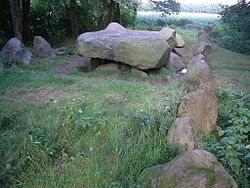Bülzenbett
| Bülzenbett | ||
|---|---|---|
|
The Bülzenbett |
||
|
|
||
| Coordinates | 53 ° 39 '33.2 " N , 8 ° 36' 56.1" E | |
| place | Sievern , Lower Saxony , Germany | |
| Emergence | 3500 to 2800 BC Chr. | |
| Sprockhoff no. | 608 | |
The Bülzenbett is a megalithic system of the Neolithic Funnel Beaker Culture (TBK) in Sievern in the district of Cuxhaven in the Elbe-Weser triangle . It originated between 3500 and 2800 BC. The passage grave is a type of Neolithic megalithic system, which consists of a chamber and a structurally separated, lateral passage. This form is primarily found in Denmark, Germany and Scandinavia, as well as occasionally in France and the Netherlands. Neolithic monuments are an expression of the culture and ideology of Neolithic societies. Their origin and function are considered to be the hallmarks of social development.
location
About 500 meters north of the village, an archaeological hiking trail turns to the east , which cuts through the Pipinsburg and other archaeological monuments. The Bülzenbett is located between Sievern and Holßel, on the edge of the Hohen Lieth, in a small wood.
description
The Bülzenbett has a trapezoidal border around 35 m long. Of their original 55 stones, 33 still exist. Many are still in their original position, some were set up again during the renovation in 1970. They form a trapezoid tapering to the east with the dimensions 8.5 by 6.5 × 35.5 meters.
In the western part of the enclosure lies the 8 × 4.7 meter large chamber, with internal dimensions of around 2.0 by 2.5 × 6 meters with the three large cap stones, one of which measures 4 × 3 meters. The middle capstone was blown up between 1604 and 1755, it still has a number of wedge holes and has partially fallen into the interior. The ceiling rests on nine supporting stones. A bearing stone on the southern long side is missing. It could not be clarified whether it was a passage grave or a large dolmen .
The Bülzenbett was shown in 1605 by Geographicus and Historicus Wilhelm Dilich (1571–1655) in his work on the Bremen area (Urbis Bremae et praefecturarum quas habet typus et chronicon). It shows a stone grave, which with great certainty represents the then still intact Bülzenbett. The picture is the oldest pictorial representation of a large stone grave in German literature. As early as 1755 (published only in 1838) the pastor and prehistoric researcher Martin M. Mushard (1699–1770) depicted the already damaged bed of bushes in his Palaeogentilism Bremensis .
In the middle of the 19th century a small stone chamber was found inside the enclosure, in which a hatchet and a flint dagger were found.
Artifacts that are kept in the Bederkesa Castle Museum show that the facility was not only visited by members of the funnel cup culture. There was also evidence that the facility was re- used during the bell beaker culture .
In the immediate vicinity are:
See also
Web links
literature
- Hans Aust: The large stone grave Bülzenbett near Sievern. In: Guide to Prehistoric and Protohistoric Monuments. Volume 31. The Elb-Weser Triangle III: Excursions: Bremerhaven · Cuxhaven · Worpswede. Verlag Philipp von Zabern, Mainz 1976, ISBN 3-8053-0146-4 , pp. 47-51.
- Hans Aust: The prehistory and early history of the district of Cuxhaven, part I Altkreis Wesermünde, diss. Phil. Hamburg (typescript) 1982
- Hans Gummel : The Bülzenbett zu Sieven in old writings 1954
- Ernst Sprockhoff : Atlas of the megalithic tombs of Germany. Part 3: Lower Saxony - Westphalia. Rudolf-Habelt Verlag, Bonn 1975, ISBN 3-7749-1326-9 , pp. 3-4.
Individual evidence
- ↑ J. Müller In: Varia neolithica VI 2009 p. 15
- ↑ Urbis Bremae et praefecturarum quas habet typus et chronicon. Von Dilich, Wilhelm, circa 1610, signature: Hist.urb.Germ.377, p. 77





